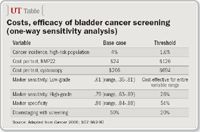Article
Bladder cancer screening appears to save lives, money
Author(s):
Dallas-A new study shows that screening high-risk populations for bladder cancer may save both lives and money. That conclusion stands in sharp contrast to screening programs for other cancers, which save lives but increase costs.

"If you can identify the appropriate high-risk group, you can always save lives with screening," said Yair Lotan, MD, assistant professor of urology at the University of Texas Southwestern Medical Center, Dallas. "The question is, at what cost? Here, we have a model that suggests that it is cheaper to screen high-risk populations for bladder cancer than to not screen."

Bladder cancer is a good disease for screening, Dr. Lotan noted. The primary risk factors-age 50 years or older, a history of smoking or exposure to environmental and occupational toxins, such as petroleum distillates or aniline dyes, are well defined.
The disease has a high prevalence. One-fourth of patients present with advanced disease and poor prognosis. But nearly all patients who are diagnosed early, with disease confined to the bladder mucosa, can expect to live at least 5 years without dying of their disease.
Screening model
Dr. Lotan created a model based on several assumptions. The population was assumed to have a 4% annual incidence of bladder cancer and a 50% downstaging of cancers from muscle-invasive to organ-confined disease due to early detection. An earlier study using the NMP22 BladderChek test (Matritech, Newton, MA) to detect bladder cancer in patients with either hematuria or symptoms found a 6% incidence rate of bladder cancer over 9 months. A study evaluating screening using hematuria home dipstick testing found an 80% risk reduction of muscle-invasive disease due to earlier diagnosis.
Even using conservative assumptions, screening would remain cost-effective as long as the test costs less than $126 and the incidence of bladder cancer in the screened population is greater than 1.6%.
"This issue of bladder cancer screening has been around for some time," Dr. Lotan commented. "What is different now that we have a more sensitive, more specific test available."
Dr. Lotan studied the effect Bladder-Chek, an FDA-approved in-office test for the screening and monitoring of bladder cancer. It is an assay for NMP22, a protein marker that is present in small amounts in the urine of healthy individuals, but is elevated in bladder cancer patients, even at very early stages. The test produces results in 30 minutes and costs about $24.
"We have a test that is available commercially at a very affordable price," Dr. Lotan said. "In theory, every primary care physician could start screening high-risk patients tomorrow. But we need to validate this model with a prospective trial in an asymptomatic population. It is a very promising model, but at this point, it is only a model."
A prospective trial with asymptomatic, high-risk patients is already under way. About 150 subjects have enrolled thus far, Dr. Lotan reported. He said preliminary data should be available in about a year.
















